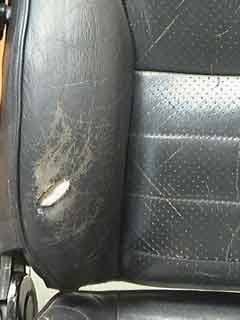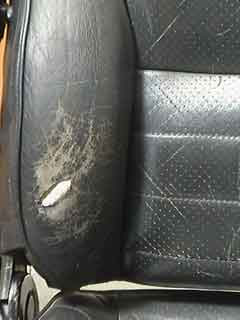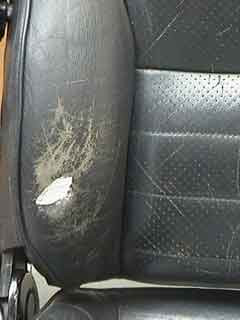How Do You Fix Leather Car Seats Like A Pro

Are you wondering How Do You Fix Leather Car Seats effectively and professionally? At CARDIAGTECH.NET, we understand the importance of maintaining the luxurious look and feel of your car’s interior. Our comprehensive guide provides step-by-step solutions, expert tips, and the best products to restore your leather car seats to their former glory. Learn about leather upholstery repair, automotive leather care, and professional leather restoration techniques to keep your car seats looking pristine.
1. Understanding Leather Car Seat Damage
Leather car seats can suffer various types of damage. Identifying the specific issue is the first step toward effective repair.
1.1. Types of Leather Damage
- Cracks and Creases: Common in older vehicles, these are caused by repeated use and lack of maintenance.
- Scratches: Often from keys, pets, or sharp objects.
- Stains: From spills, food, or dyes.
- Fading: Caused by prolonged exposure to sunlight.
- Holes and Tears: More severe damage that requires immediate attention.
- Color Transfer: Dye from clothing transferring onto the leather.
1.2. Factors Contributing to Damage
Several factors contribute to the wear and tear of leather car seats:
- UV Exposure: Sunlight can fade and dry out leather.
- Temperature Fluctuations: Extreme heat and cold can cause leather to crack.
- Lack of Regular Cleaning: Dirt and grime can accelerate wear.
- Spills and Accidents: Can cause stains and damage the leather’s surface.
- Friction: Constant rubbing can wear down the leather’s protective coating.
2. Essential Tools and Products for Leather Car Seat Repair
Having the right tools and products is crucial for a successful repair. CARDIAGTECH.NET offers a wide range of high-quality solutions designed for professional and DIY use.
2.1. Cleaning and Preparation
- Leather Cleaner: Specifically formulated to remove dirt and grime without damaging the leather.
- Leather Prep: An abrasive pad to gently remove grease and oils, preparing the surface for repair.
- Alcohol Cleaner: Removes any remaining dirt or dust after prepping.
- Soft Microfiber Cloths: For gentle cleaning and wiping.
2.2. Repairing Damage
- Leather Repair Kit: Includes essential items like leather glue, heavy filler, and a sub-patch.
- Leather Glue: For bonding the backing patch and edges of the hole.
- Heavy Filler: Used to fill in holes and cracks.
- Leather Sub-Patch: Provides a firm backing for the repair.
- Palette Knife/Spatula: For applying filler smoothly and evenly.
- Scalpel or Scissors: To trim away any protruding leather.
- Sandpaper: Fine-grit sandpaper to smooth out the filler.
2.3. Coloring and Finishing
- Leather Colorant Kit: Matched to the color of your leather for seamless repairs.
- Airbrush: For applying thin, even coats of colorant.
- Sponges: For applying an initial coat of colorant to penetrate the leather’s creases.
- Leather Finish: Seals the colorant, preventing wear and prolonging the leather’s life.
3. Step-by-Step Guide: How to Fix Leather Car Seats
Follow these detailed steps to repair various types of damage to your leather car seats effectively.
3.1. Repairing Cracks and Creases
-
Clean the Area: Use a leather cleaner to remove any dirt or grime.
Alt text: Cleaning car seat leather with a specialized leather cleaner to remove dirt and grime effectively.
-
Apply Leather Conditioner: A high-quality leather conditioner can help restore moisture and flexibility.
-
Massage the Conditioner: Gently massage the conditioner into the cracks and creases.
-
Allow to Absorb: Let the conditioner absorb for at least 24 hours.
-
Wipe Off Excess: Wipe off any excess conditioner with a clean microfiber cloth.
-
Repeat if Necessary: For deep cracks, repeat the process for optimal results.
3.2. Removing Scratches
-
Clean the Surface: Use a leather cleaner to clean the scratched area.
Alt text: Cleaning a scratch on a leather car seat using a leather cleaner to prepare for scratch removal.
-
Apply Leather Filler: Use a small amount of leather filler to fill the scratch.
-
Smooth the Filler: Use a palette knife to smooth the filler, ensuring it’s level with the surrounding leather.
-
Allow to Dry: Let the filler dry completely, usually for about 30 minutes.
-
Sand Lightly: Use fine-grit sandpaper to smooth the surface.
-
Apply Colorant: Use a leather colorant that matches your car seat’s color to blend the repair.
-
Apply Leather Finish: Seal the repair with a leather finish.
3.3. Removing Stains
-
Identify the Stain: Different stains require different cleaning methods.
-
Act Quickly: The sooner you treat a stain, the easier it will be to remove.
-
Use a Leather Cleaner: Apply a small amount of leather cleaner to a microfiber cloth.
Alt text: Removing a stain from a leather car seat using a specialized leather cleaner applied with a microfiber cloth.
-
Gently Blot the Stain: Avoid rubbing, as this can spread the stain.
-
Dry the Area: Use a clean, dry microfiber cloth to dry the area.
-
For Stubborn Stains: Use a specialized stain remover designed for leather.
-
Reapply Conditioner: After cleaning, reapply a leather conditioner to restore moisture.
3.4. Repairing Fading
- Clean the Leather: Remove any dirt and grime with a leather cleaner.
- Apply Leather Colorant: Use a colorant that matches your car seat’s original color.
- Apply Thin Coats: Apply several thin coats of colorant using an airbrush for even coverage.
- Allow to Dry: Let each coat dry completely before applying the next.
- Apply Leather Finish: Seal the colorant with a leather finish to protect against further fading.
3.5. Repairing Holes and Tears
- Prepare the Area: Clean the area around the hole or tear with a leather prep and alcohol cleaner.
 Preparing a damaged leather car seat for hole repair
Preparing a damaged leather car seat for hole repair - Tidy the Area: Remove any protruding leather using a scalpel or scissors.
- Apply Backing Patch: Cut a leather sub-patch slightly larger than the hole and insert it under the leather, using leather glue to secure it.
 Applying a backing patch to a leather car seat
Applying a backing patch to a leather car seat - Fill the Hole: Apply heavy filler in thin layers, allowing each layer to dry before applying the next.
 Filling a hole in a leather car seat with heavy filler
Filling a hole in a leather car seat with heavy filler - Smooth the Surface: Use fine-grit sandpaper to smooth the filler, ensuring it’s level with the surrounding leather.
- Apply Colorant: Use a leather colorant to match the car seat’s color.
 Applying colorant to a repaired leather car seat
Applying colorant to a repaired leather car seat - Apply Leather Finish: Seal the repair with a leather finish for protection and longevity.
3.6. Addressing Color Transfer
- Clean the Area: Use a leather cleaner to gently clean the affected area.
- Use a Color Transfer Remover: Apply a specialized color transfer remover to a microfiber cloth.
- Gently Blot: Gently blot the area, avoiding rubbing.
- Dry the Area: Use a clean, dry microfiber cloth to dry the area.
- Reapply Conditioner: Restore moisture with a leather conditioner.
4. Advanced Techniques for Leather Car Seat Repair
For more complex repairs, consider these advanced techniques to achieve professional results.
4.1. Leather Recoloring
If your leather car seats have significant fading or discoloration, recoloring may be necessary. This involves stripping the old finish and applying a new colorant.
- Prepare the Leather: Clean the leather thoroughly and use a leather degreaser to remove any oils or waxes.
- Apply Leather Binder: This helps the new colorant adhere to the leather.
- Apply Colorant: Use an airbrush to apply several thin, even coats of the new colorant.
- Apply Leather Finish: Seal the colorant with a leather finish.
4.2. Replacing Leather Panels
For severely damaged leather, replacing the entire panel may be the best option. This requires specialized skills and tools.
- Remove the Damaged Panel: Carefully remove the damaged leather panel from the seat.
- Create a Template: Use the old panel as a template to cut a new panel from matching leather.
- Sew the New Panel: Sew the new panel onto the seat, ensuring a tight and seamless fit.
4.3. Professional Leather Restoration Services
If you’re not comfortable performing these repairs yourself, consider hiring a professional leather restoration service. CARDIAGTECH.NET can connect you with experienced technicians who can restore your leather car seats to their original condition.
5. Maintaining Leather Car Seats for Longevity
Proper maintenance is essential to keeping your leather car seats in excellent condition.
5.1. Regular Cleaning
- Frequency: Clean your leather car seats every 1-3 months, depending on usage.
- Products: Use a pH-balanced leather cleaner and soft microfiber cloths.
- Technique: Gently wipe down the seats, paying attention to areas that come into contact with skin.
5.2. Conditioning
- Frequency: Apply leather conditioner every 3-6 months.
- Products: Choose a high-quality leather conditioner that moisturizes and protects the leather.
- Technique: Apply a small amount of conditioner to a microfiber cloth and massage it into the leather. Allow it to absorb for at least 24 hours, then wipe off any excess.
5.3. Protection from the Elements
- Parking: Park in the shade or use a car cover to protect your leather seats from UV exposure.
- Window Tinting: Consider window tinting to reduce the amount of sunlight entering your car.
- Leather Protectant Sprays: Use a leather protectant spray to create a barrier against UV rays and spills.
5.4. Prompt Spill Cleanup
- Act Immediately: Clean up spills as soon as they occur to prevent staining.
- Blot, Don’t Rub: Use a clean microfiber cloth to blot the spill, working from the outside in.
- Use a Leather Cleaner: If necessary, use a leather cleaner to remove any remaining residue.
6. Common Mistakes to Avoid
Avoid these common mistakes to ensure successful leather car seat repairs and maintenance.
6.1. Using Harsh Chemicals
Avoid using harsh chemicals, such as bleach or ammonia-based cleaners, as these can damage the leather’s surface and cause discoloration.
6.2. Over-Conditioning
Applying too much conditioner can leave a sticky residue and attract dirt. Always use a small amount and allow it to absorb fully.
6.3. Neglecting Regular Cleaning
Failing to clean your leather car seats regularly can lead to a buildup of dirt and grime, accelerating wear and tear.
6.4. Rubbing Stains
Rubbing stains can spread them and push them deeper into the leather. Always blot gently to lift the stain.
6.5. Ignoring Minor Damage
Ignoring minor damage, such as small scratches or cracks, can lead to more significant problems over time. Address these issues promptly to prevent further deterioration.
7. Benefits of Professional Leather Car Seat Repair
While DIY repairs can be effective, professional leather car seat repair offers several advantages.
7.1. Expertise and Experience
Professional technicians have the expertise and experience to assess the damage accurately and choose the most appropriate repair methods.
7.2. High-Quality Products
Professionals use high-quality products and tools that are not typically available to consumers, ensuring a long-lasting and seamless repair.
7.3. Time Savings
Professional repairs can save you time and effort, allowing you to focus on other tasks.
7.4. Guaranteed Results
Many professional services offer warranties or guarantees on their work, providing peace of mind.
7.5. Preservation of Value
Properly repaired and maintained leather car seats can help preserve your vehicle’s value.
8. Cost Considerations for Leather Car Seat Repair
The cost of repairing leather car seats can vary depending on the type and extent of the damage.
8.1. DIY Repair Costs
DIY repairs can be more cost-effective for minor damage, with the cost of cleaning and repair products ranging from $20 to $100.
8.2. Professional Repair Costs
Professional repairs can range from $100 to $500 or more per seat, depending on the complexity of the repair.
8.3. Factors Affecting Cost
- Type of Damage: Simple cleaning and conditioning are less expensive than repairing holes or replacing panels.
- Extent of Damage: More extensive damage requires more time and materials, increasing the cost.
- Type of Leather: Some types of leather are more expensive to repair than others.
- Location: Labor costs can vary depending on your location.
8.4. Cost-Benefit Analysis
Consider the long-term benefits of repairing your leather car seats, such as preserving your vehicle’s value and maintaining its aesthetic appeal.
9. Innovations in Leather Car Seat Repair Technology
The field of leather car seat repair is constantly evolving, with new technologies and techniques emerging to improve the quality and efficiency of repairs.
9.1. Advanced Color Matching Systems
Advanced color matching systems use spectrophotometers to precisely match the color of your leather car seats, ensuring a seamless repair.
9.2. Laser Repair Technology
Laser repair technology can be used to repair minor scratches and imperfections in leather car seats with precision and minimal damage.
9.3. Environmentally Friendly Products
Many manufacturers are now offering environmentally friendly leather cleaning and repair products that are safer for you and the planet.
9.4. Nanotechnology Coatings
Nanotechnology coatings can be applied to leather car seats to provide a durable and long-lasting barrier against stains, UV rays, and wear and tear.
10. CARDIAGTECH.NET: Your Partner in Leather Car Seat Repair
At CARDIAGTECH.NET, we are committed to providing you with the best products and services for leather car seat repair.
10.1. High-Quality Products
We offer a wide range of high-quality leather cleaning, repair, and maintenance products from trusted brands.
10.2. Expert Advice
Our team of experts can provide you with personalized advice and guidance to help you choose the right products and techniques for your specific needs.
10.3. Convenient Online Ordering
You can easily order our products online and have them delivered directly to your door.
10.4. Customer Support
We offer excellent customer support to answer your questions and help you with any issues you may encounter.
10.5. Contact Information
- Address: 276 Reock St, City of Orange, NJ 07050, United States
- WhatsApp: +1 (641) 206-8880
- Website: CARDIAGTECH.NET
FAQ: Frequently Asked Questions About Leather Car Seat Repair
1. What is the best way to clean leather car seats?
Use a pH-balanced leather cleaner and a soft microfiber cloth. Gently wipe down the seats, paying attention to areas that come into contact with skin.
2. How often should I condition my leather car seats?
Condition your leather car seats every 3-6 months to keep them moisturized and protected.
3. Can I use household cleaners on leather car seats?
No, avoid using household cleaners as they can damage the leather’s surface and cause discoloration.
4. How do I remove stains from leather car seats?
Act quickly and use a leather cleaner to gently blot the stain. Avoid rubbing, as this can spread the stain.
5. What causes leather car seats to crack?
Exposure to UV rays, temperature fluctuations, and lack of regular conditioning can cause leather car seats to crack.
6. How can I protect my leather car seats from sun damage?
Park in the shade, use a car cover, or consider window tinting to reduce the amount of sunlight entering your car.
7. Is it possible to repair a tear in a leather car seat?
Yes, small tears can be repaired using a leather repair kit. For larger tears, it may be necessary to replace the entire panel.
8. How much does it cost to repair leather car seats professionally?
Professional repairs can range from $100 to $500 or more per seat, depending on the complexity of the repair.
9. What are the benefits of professional leather car seat repair?
Professional repairs offer expertise, high-quality products, time savings, guaranteed results, and preservation of value.
10. Where can I find high-quality leather car seat repair products?
You can find high-quality leather car seat repair products at CARDIAGTECH.NET.
Leather car seats are a luxurious addition to any vehicle, but they require proper care and maintenance to stay in top condition. By following the tips and techniques outlined in this guide, you can keep your leather car seats looking their best for years to come. For all your leather car seat repair needs, trust CARDIAGTECH.NET to provide you with the best products, expert advice, and exceptional customer support. Don’t wait—contact us today via WhatsApp at +1 (641) 206-8880 or visit our website at CARDIAGTECH.NET to learn more and get started!
Are you facing challenges with your leather car seats and unsure how to proceed? Do you want to ensure the longevity and pristine condition of your car’s interior? Contact CARDIAGTECH.NET now for expert advice and the best tools to tackle any leather repair job! Our team is ready to assist you with personalized solutions tailored to your needs. Reach out today and let us help you restore the beauty and comfort of your leather car seats!

